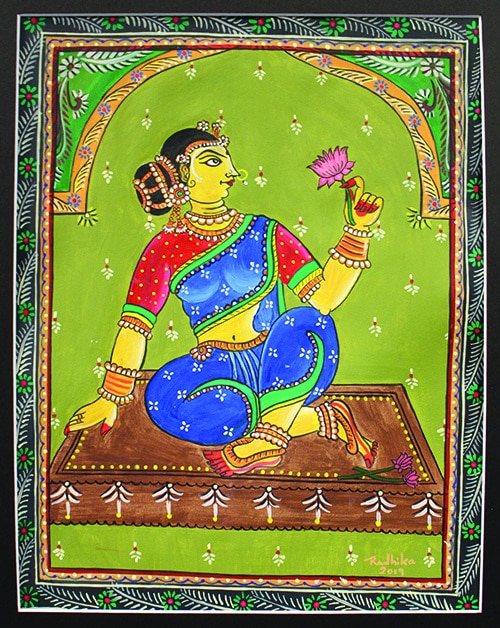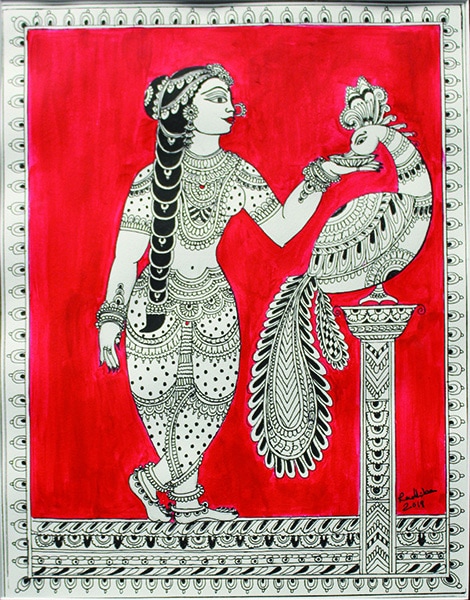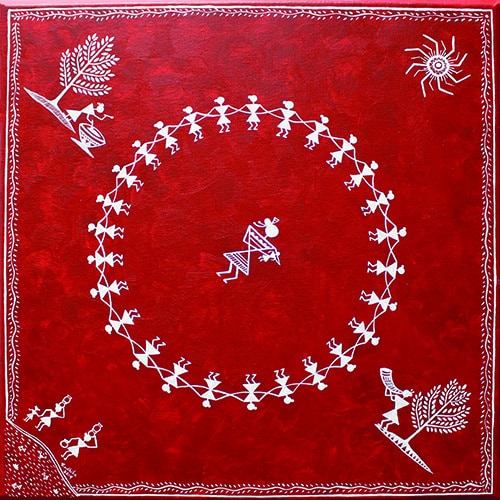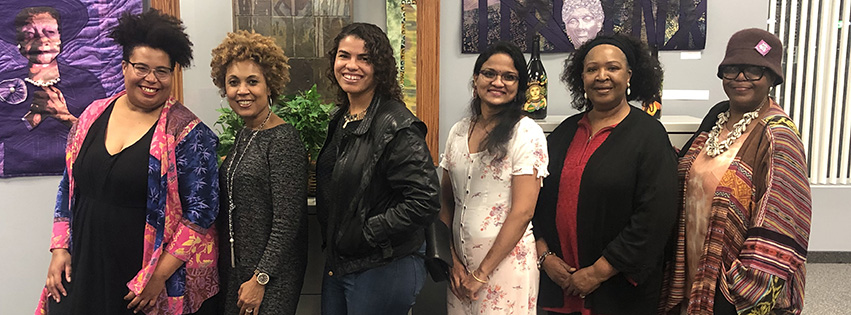The traditional forms of artwork found in India are as diverse as the nation itself. Passed down from generation to generation, they represent the ever-evolving beliefs and interests of Indian culture. Sometimes vibrant and complex, and other times simple and direct, these many distinctive styles have been celebrated for their beauty for centuries.
Here in Peoria, a local artist is reproducing these traditional forms of Indian art in order to keep them alive. Radhika Raghavendra has spent hours watching YouTube videos, reading and consulting other resources to learn as much as she can, albeit at a distance. In doing so, she is helping to introduce central Illinois to India’s rich cultural heritage through the language of art.

Connecting to Her Roots
The only artist in her family, Radhika sketched with pencils as a child and was heavily involved in the performing arts as a dancer. “I didn’t take any formal training for painting,” she explains. “I used to take part in school competitions, and I got encouragement from teachers. At the same time I got into dance, and that became my passion. Drawing was just a hobby.”
She successfully pursued a degree in computer science, though she admits she did so half-heartedly. “I was more interested in dance,” she concedes with a laugh. “I learned a classical dance form called Bharatanatyam.”
One of the eight classical dances of India, Bharatanatyam remained exclusive to Hindu temples through the 19th century. Radhika has twelve years of training in Bharatanatyam, which qualifies her to teach this style of dance.
Since moving to the United States five years ago due to her husband’s work, she has lived in Michigan and Wisconsin, as well as Peoria. She says her affinity for traditional Indian art forms helps her feel connected to her roots. “It makes me feel proud,” she observes. “I am connecting to my country through it.”
Radhika recently exhibited her artwork to the public for the first time. Her body of work, entitled Shakti Mukhagalu, is difficult to translate directly into English. Shakti is the female principle of divine energy, while she translates the word mukhagalu as “facets.” “I am comparing shakti to the power of feminine,” she explains. “I have tried to show different facets of women through my art form.” This work is part of the Imaging exhibition on display at Peoria Magazines through December 24, 2019. In this group exhibition highlighting six women of color, Radhika’s art is represented by pieces in six different forms.

Styles and Tradition
Radhika uses the term vaividhya, which means “variety” or “diversity,” to describe her many artistic pursuits. Perhaps one of the most striking styles she has reproduced is Madhubani, which comes from the Mithila region in northeastern India. This type of painting was traditionally created by women on the freshly plastered mud walls and floors of huts. Like other traditional forms of Indian art, Madhubani paintings often depict the epic tales of deities, but Radhika takes a different approach. “If it’s a rule in a style that I do something related to religion, then I will do it,” she explains. “But nowadays people paint according to their own varied interests.”
In a Madhubani painting she recently completed, a woman sits under a tree. “She’s just sitting,” Radhika adds. “There is no story behind it.” This is perhaps what makes her Madhubani painting so intriguing—she has captured an otherwise mundane moment in a spectacular and colorful way.
The Madhubani style requires that all objects be outlined with a single line. If you look closely, a black line can be found around each design element—right down to each individual leaf on the tree. “When I first did Madhubani, I didn’t know that I had to draw a border for everything,” she recalls, chuckling. And because no space can be left empty, she fills the canvas with painstakingly painted geometric designs, as well as flowers, birds and animals.
In sharp contrast to Radhika’s colorful and intricate Madhubani paintings, her Warli art is far more minimalistic. “Warli is a tribal art form and also the name of that tribal group,” she explains. “Usually they paint it on their house walls.”

Farming is a way of life for the Warli, whose artwork is based on shapes found in nature. “The circle is derived from the moon and sun, and these triangles are from the mountains and trees,” she points out. While they hold many beliefs derived from sacred Hindu texts, the Warli have their own distinct set of beliefs as well. “Everything is related to nature, and nothing related to religion or mythology,” she notes, setting it apart from many other traditional forms of Indian art.
Pattachitra artwork is another distinctive style—one of the oldest art forms in the eastern Indian state of Odisha, known for its intricate details and mythological narratives. In one of Radhika’s Pattachitra paintings, entitled Atmavishwasa (meaning “self-confident”), a woman sits with a slight smile on her face, holding a lotus flower. “My parents visited a place where the whole village was doing this type of painting,” she recalls. “It was an art village!”
Radhika also paints in her own unique style—informed by tradition, but unbeholden to any rules. She recently depicted Mirabai, a 16th century Hindu mystic poet. In this painting, you will see a peacock feather—a symbol that points to Lord Krishna, of which Mirabai was a devotee. Another piece, Shodhaki, or “Explorer,” is equally striking, though far less colorful than her more traditional work. “This is one of my favorites… because she is a dancer,” she explains. “I wanted to talk about the different facets of women, and she is here to explore. She has a lot more to learn.”
 In addition to painting on canvas, Radhika also utilizes bottles and rocks as mediums. This might seem curious for traditional Indian artwork, but she says it makes sense due to how often her family moves. “I just kept moving from one state to another, and it is difficult to move a canvas,” she notes. “If I give a painting as a gift, I don’t know if they will have space to display a canvas. So, I thought, why not paint it on a bottle? You can keep it anywhere and carry it easily!”
In addition to painting on canvas, Radhika also utilizes bottles and rocks as mediums. This might seem curious for traditional Indian artwork, but she says it makes sense due to how often her family moves. “I just kept moving from one state to another, and it is difficult to move a canvas,” she notes. “If I give a painting as a gift, I don’t know if they will have space to display a canvas. So, I thought, why not paint it on a bottle? You can keep it anywhere and carry it easily!”
Art as a Way of Life
Looking forward, Radhika hopes to deepen her understanding of traditional Indian artwork. “One thing I have always said I should do is 100 percent a traditional method,” she says. “I don’t know when I will get that chance. I may have to go to [India], because you cannot learn all of the methods from YouTube.”
She does fear, however, that traditional Indian art may not be popular enough for new generations to learn. “Even I didn’t learn about traditional paintings until after I was married,” she laughs. “People feel like the traditional paintings are boring, and want to do abstract or modern paintings. If anyone is interested, I would love to teach them.”
Though she is unsure where her family will be living in the future, she will always have her artwork—and dance—as a companion. For Radhika, this has been a positive force that has helped her grow as a person, like countless generations before her. “Art is helping me to be positive in life,” she explains. “Art and painting work as a color therapy. It eliminates all those negative thoughts and energy in and around me, and helps me be refreshed.” PM
To learn more about the artwork of Radhika Raghavendra, visit facebook.com/vaividhyakale.




